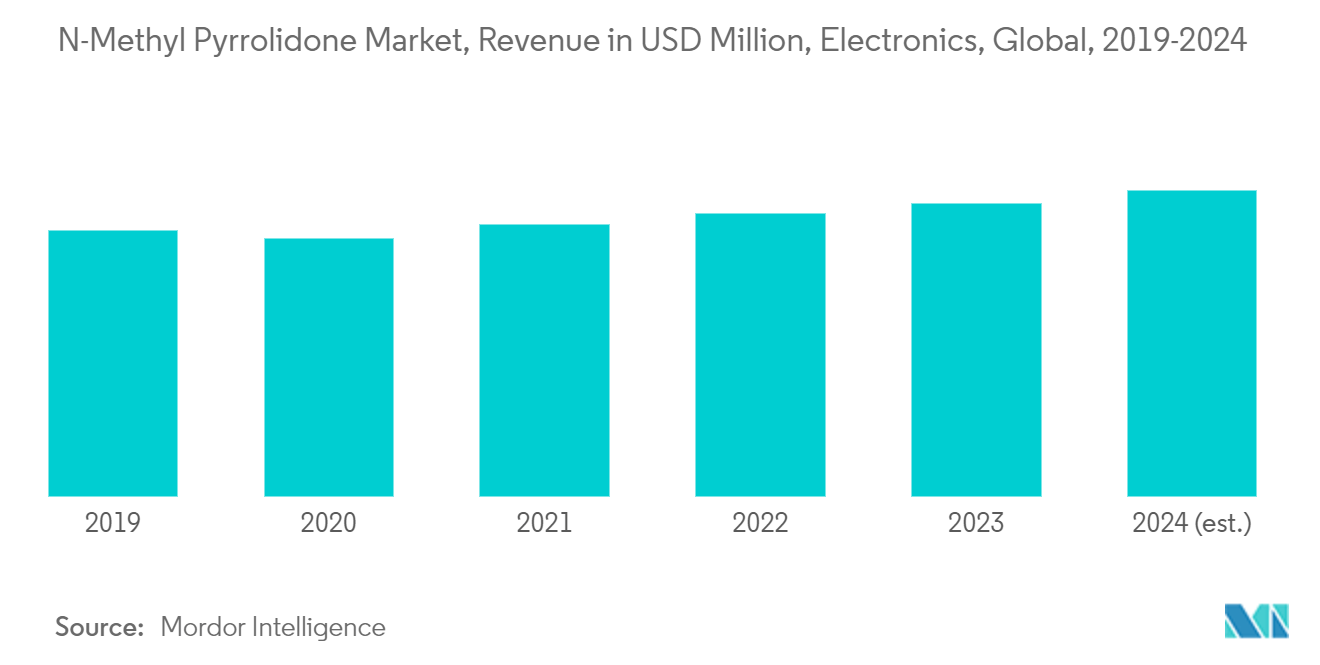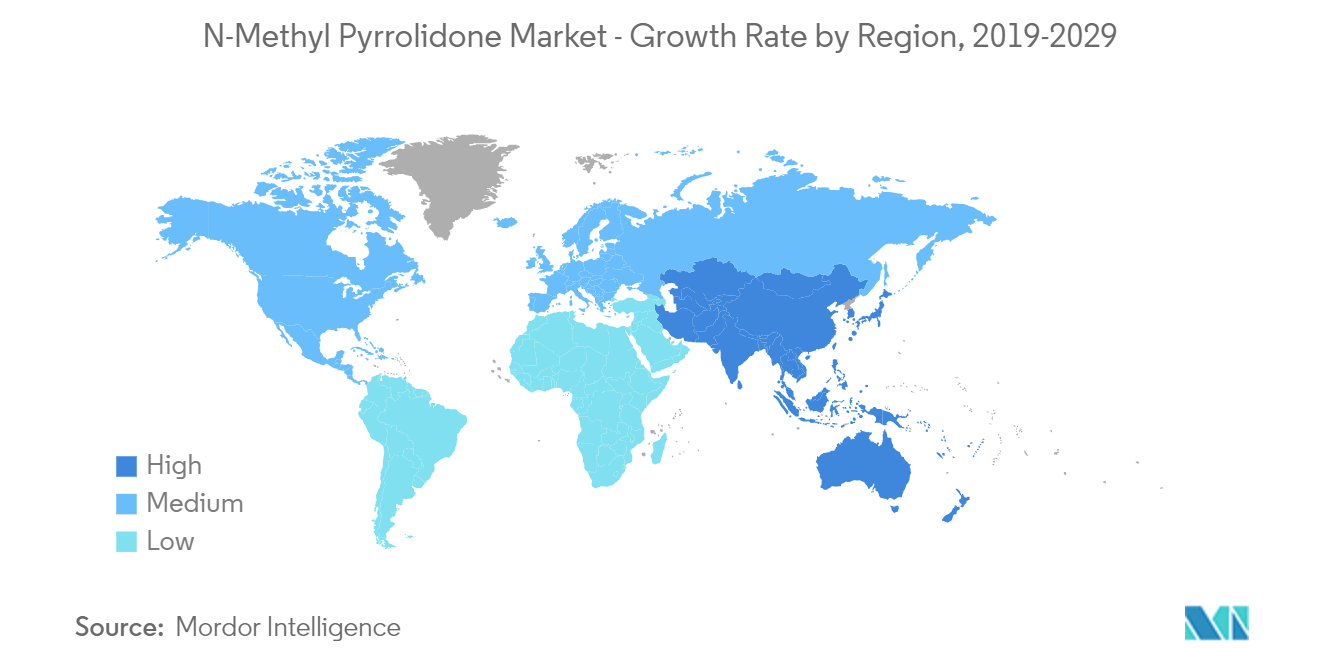Market Trends of N-Methyl Pyrrolidone Industry
Increasing Demand from Electronics Segment
- N-methyl pyrrolidone is an organic compound that is produced industrially by ester-to-amide conversion. It consists of 5-membered lactam and is a colorless liquid that is miscible with water and with most common organic solvents.
- The application of n-methyl pyrrolidone in the electronics industry is increasing owing to its usage in the production of lithium-ion batteries for electric vehicles, semiconductor device fabrication, and wire enamel coating. It is also used for the removal of excess burr at the time of production of various electronic parts.
- N-methyl pyrrolidone is widely used as a solvent in the production of conformal coatings such as epoxy and polyurethane coatings in printed circuit boards (PCB). It is also used for degreasing, cleaning, and as a photoresist stripper.
- The production by the global electronics and IT industry was estimated at USD 3,436.8 billion in 2022, registering a growth rate of 1% year on year, compared to USD 3,415.9 billion in 2021.
- In North America, the United States launched the CHIPS and Science Act in August 2022 to support domestic production and innovation in the semiconductor industry.
- According to the German Electrical and Electronic Manufacturers Association (ZVEI), the global electro and digital industry reached EUR 239 billion (USD 261.41 billion) in 2023, an increase of 6.6% compared to the previous year. Furthermore, the production revenue of the same industry increased by 0.4% in 2023 compared to 2022. This is likely to raise the demand for n-methyl pyrrolidone owing to the rising electronics industry in Germany.
- In the Asia-Pacific, India launched a comprehensive program for the development of semiconductors and display manufacturing ecosystems in the country. The government announced an outlay of INR 76,000 crore (~USD 10 billion). Fiscal support of 50% of the project cost is provided by the government to set up display fabs and semiconductor fabs, and fiscal support of 50% of capital expenditure for compound semiconductors fab.
- According to the Japan Electronics and Information Technology Industries Association (JEITA), the production by the global electronics and IT industries in the year 2024 is expected to achieve 9% growth after an estimated decline of 3% in the year 2023
- All such factors are expected to drive the market for n-methyl pyrrolidone over the forecast period.

Asia-Pacific to Dominate the Market
- Asia-Pacific is expected to dominate the market for n-methyl pyrrolidone during the forecast period. In countries like China, Japan, and India, the demand for n-methyl pyrrolidone is increasing owing to significant growth in various end-user industries, such as oil and gas, pharmaceutical, and electronics industries.
- The usage of n-methyl pyrrolidone in the oil and gas industry is increasing as it is used as an extraction medium in several applications, like BTX extraction, lube oil purification, and butadiene recovery. There are nearly 825 operational crude oil refineries worldwide and 190 planned refineries as of 2023. According to the International Energy Agency’s (IEA) oil market report of June 2022, net global refining capacity expanded by 1.0 million b/d in 2022 and is expected to expand by an additional 4.4 million b/d by 2028.
- In the electronics industry, n-methyl pyrrolidone is used as a solvent in the production of flexible polyimide copper clad board (FCCL) and in the production of photoresists, which are used in the production of printed circuit boards, flat panel liquid crystal displays, micro electro mechanical systems (MEMs), and integrated circuit (IC) devices including microprocessors and memory chips.
- China dominates electronics production in the global market. The country's electronics production, which has steadily increased over the years, has recently suffered from deceleration owing to the ongoing trade war between China and the United States, forcing various electronics producers to shift their base from China to other countries in Asia-Pacific.
- According to the World Semiconductor Trade Statistics (WSTS), as of November 2023, China is the largest market in Asia, accounting for 55% of the region’s market and 31% of the total global market. However, as of January 2024, according to the General Administration of Customs of the People's Republic of China, the country saw semiconductor import value drop in 2023, signaling the US export curbs, China's indigenization efforts, and a low demand for electronics.
- In the pharmaceutical sector, China’s growing population and healthcare industry drive the demand for NMP as a solvent and carrier for pharmaceutical formulations, as well as drug delivery systems. China is one of the largest markets for pharmaceutical products. In 2026, according to the AstraZeneca report, the estimated pharmaceutical sales in the country are expected to be worth USD 189 billion.
- In India, the domestic electronics manufacturing sector has been expanding steadily, owing to favorable government policies, such as 100% foreign direct investment (FDI), no requirement for an industrial license, and the technological transformation from manual to automatic production processes. New incentives, such as the Modified Incentive Special Package Scheme (M-SIPS) and Electronics Development Fund (EDF), were started in India in August 2023 with a budget of USD 114 million for domestic electronics manufacturing.
- According to the data released by the Japanese Electronics and Information Technology Industries Association (JEITA), in 2023, the total production value of the electronics industry in Japan accounted for around JPY 10.7 trillion. The industry encompasses consumer electronic equipment, industrial electronic equipment, as well as electronic components and devices.
- All aforementioned factors, coupled with government support, are contributing to the increasing demand for n-methyl pyrrolidone.


